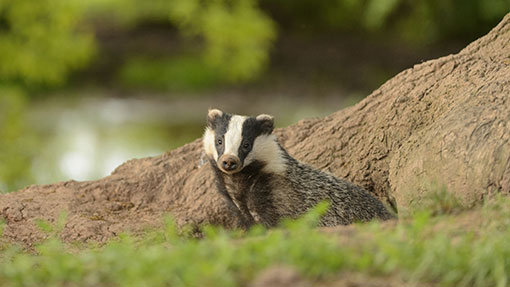Badger setts double in England over past 25 years

The number of active badger setts in England has doubled over the past 25 years in England, new research shows.
The survey, which was conducted over the past two winters, showed a 103% increase in badger setts in England compared with a survey completed between 1985 and 1988.
However, the researchers found little change in numbers of active setts in Wales, where estimated rates have remained roughly constant, between 25% and 49%.
The survey indicated that the estimated total number of badger setts in England and Wales is now 88% higher than in the mid-1980s, suggesting an average annual increase rate of 2.6%.
Researchers estimate that over this two-year period, active main badger setts were present in 34.4% of rural 1km sq in England and Wales and that the total number of main badger setts in rural England and Wales was estimated at 71,600.
But the study authors said badger sett surveys were no reliable indicator for estimating populations of individual animals, as sett characteristics are a “poor predictor of badger numbers and group size can vary widely”.
For the study, Jo Judge, a wildlife ecologist at the Animal Health and Veterinary Laboratories Agency (AHVLA), and colleagues used survey data identifying badger setts at sites across England and Wales from 2011–13 as a proxy for badger social groups and compared them to data from similar surveys conducted in 1985–88 and 1994–97.
The team surveyed a total of 1,614 random 1km squares to achieve their results, consisting of 1,411 squares in England and 203 in Wales.
Researchers said the increased numbers of badger setts was “likely” to be linked to “species protection and changes in habitat quality”.
Farmers maintain that the increase in the size and number of badger setts on farms and abundance of badgers, which are known reservoirs of TB, are factors contributing towards the dramatic increase in bovine TB in recent years.
NFU vice-president Adam Quinney said: “Farmers have been telling us for a long time that they have been seeing a growth in the number and size of badger setts on their farms and the results of this survey back up what they have said.
“Badgers have been proven to be infectious to cattle when they have TB.
“Research has shown that in hotspot areas up to one-third of badgers could be infected, which is why controlling the reservoir of disease in wildlife has to be a crucial part of any strategy to control and eradicate TB in this country.”
DEFRA and the NFU believe a badger cull can help reduce the incidence of bovine TB. But wildlife campaigners insist that culling badgers will make no difference to efforts to reduce the disease and they have called for more funding for vaccination and tougher cattle controls.
An independent panel of wildlife experts is currently reviewing two pilot culls in Somerset and Gloucestershire. Their findings will inform DEFRA secretary Owen Paterson’s decision over whether culling can be rolled out to 10 new areas this year.
However, Mark Jones, veterinarian and executive director of Humane Society International (HSI) UK, said the survey results did not in any way support arguments for badger population controls, or for any relaxation of their protected status.
“A survey of badger social groups is not the same thing at all as an estimate of individual badger numbers, and any talk of badger overpopulation is completely unfounded,” he added.
“We must remember this latest survey was conducted before last year’s pilot badger culls began, and that more recent surveys of those cull zones show a significant and extremely worrying decline in local badger populations.
“The government has neglected to investigate these declines so the cause is uncertain. However, if illegal badger persecution and foul play has occurred under the cloak of an official cull, then we risk seeing further declines in badger numbers if the culls are rolled out across England.”
The peer-reviewed study is published in the latest edition of Scientific Reports, a primary research publication from the publishers of Nature.
More on: bovine TB and the badger cull
